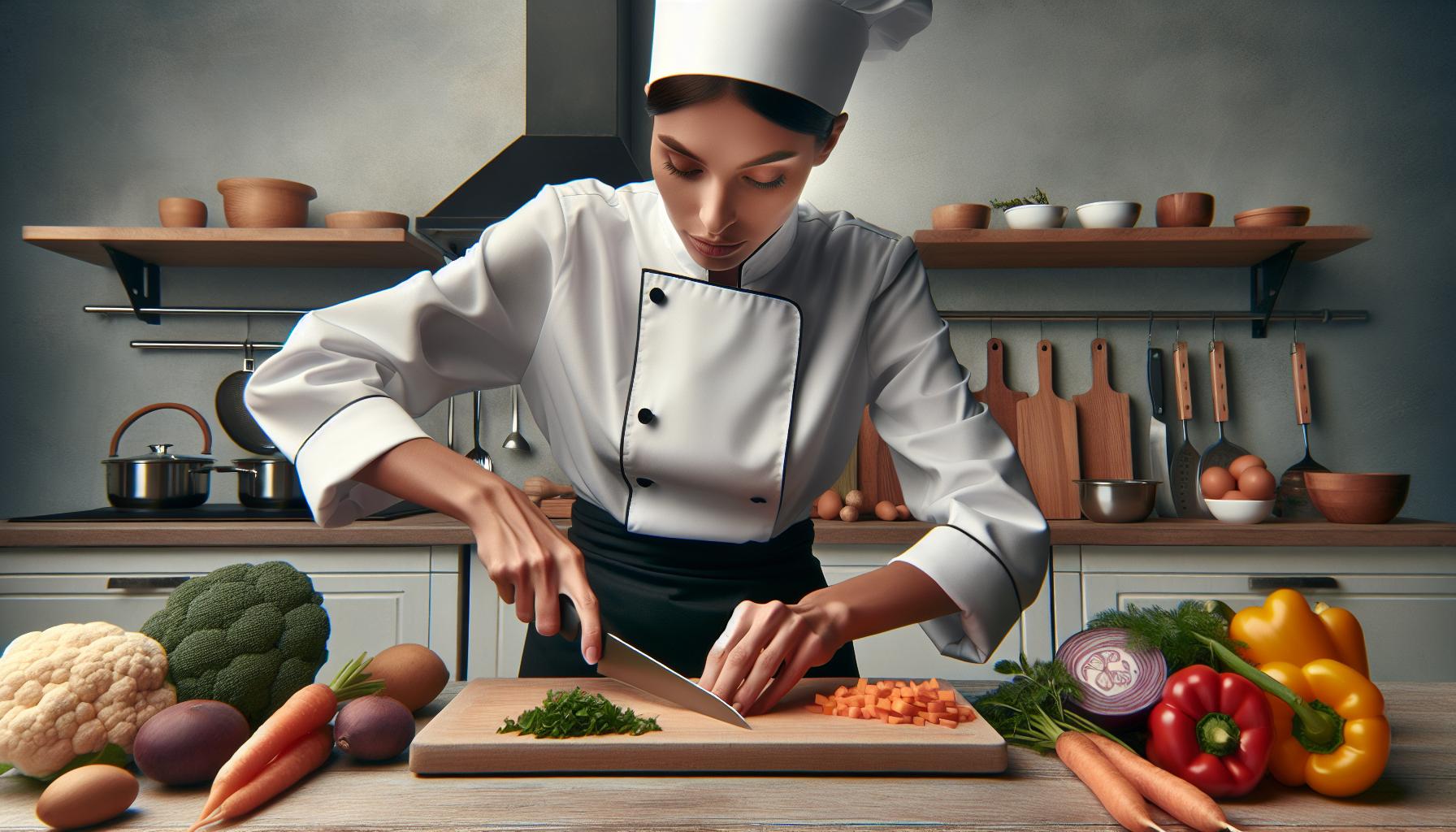The Best Fluffy Pancakes recipe you will fall in love with. Full of tips and tricks to help you make the best pancakes.
Mastering the art of cutting ingredients isn’t just about wielding a sharp knife – it’s about transforming ordinary cooking into culinary excellence. From the precise julienne to the delicate chiffonade, proper cutting techniques can elevate a home cook to chef status faster than you can say “brunoise.”
Whether you’re dicing onions without tears or creating picture-perfect vegetable matchsticks, the right cutting technique makes all the difference in cooking time, presentation and even flavor distribution. It’s not just about making food look Instagram-worthy (though that’s definitely a bonus). The way ingredients are cut affects how they cook, how they taste and how they blend with other elements in a dish. Let’s slice through the confusion and dice up the mysteries of professional cutting techniques that’ll make your cooking shine.
Basic Knife Skills Every Cook Should Master
Mastering essential knife skills forms the foundation of efficient cooking. Professional chefs employ specific gripping techniques paired with proper board handling to achieve consistent cutting results.
Proper Knife Grip and Hand Positioning
The pinch grip technique maximizes control during cutting operations. Chefs grip the blade near the handle between their thumb and forefinger while wrapping remaining fingers around the handle. The guide hand forms a claw shape, tucking fingertips under while keeping knuckles exposed to guide the blade. The thumb tucks behind the fingers for protection during slicing motions. The knife arm maintains a 20-degree angle relative to the cutting board, allowing smooth rocking motions.
Essential Cutting Board Techniques
A stable cutting board creates the platform for precise knife work. Placing a damp kitchen towel underneath prevents board movement during cutting operations. The dominant hand controls the knife while the guide hand stabilizes ingredients through a claw grip position. Ingredients align perpendicular to the knife edge for consistent cuts. The knife tip maintains contact with the board during rocking motions, creating smooth cutting strokes. The guide hand advances ingredients gradually toward the blade while maintaining proper finger positioning.
Common Vegetable Cutting Techniques

Professional vegetable cutting techniques transform basic ingredients into precise, uniform pieces that enhance both presentation and cooking consistency. Each method serves specific culinary purposes and creates distinct textures in finished dishes.
Julienne and Batonnet Cuts
Julienne cuts produce thin matchstick-shaped strips measuring 1/8 inch by 1/8 inch by 2-3 inches. These delicate strips appear in stir-fries, salads and garnishes. Batonnet cuts create slightly thicker pieces at 1/4 inch by 1/4 inch by 2-3 inches, perfect for French fries and vegetable side dishes. Here’s the standard approach:
- Square off the vegetable by cutting flat surfaces
- Cut into rectangular planks
- Stack planks and slice lengthwise
- Cut crosswise into uniform strips
Dice and Brunoise Methods
Dicing generates uniform cubes in three sizes: large (3/4 inch), medium (1/2 inch) and small (1/4 inch). Brunoise takes dicing further by creating tiny 1/8-inch cubes from julienne strips. The process includes:
- Cut vegetables into planks
- Slice planks into strips
- Rotate strips 90 degrees
- Cut across to form cubes
- Keep fingers tucked while slicing
Chiffonade and Rough Chop Styles
Chiffonade creates ribbon-like strips from leafy vegetables and herbs through a rolling technique. A rough chop produces informal, rustic cuts for casual dishes or ingredients that break down during cooking. The techniques differ:
Chiffonade:
- Stack leaves neatly
- Roll tightly into a cylinder
- Slice across into thin ribbons
- Cut ingredients into manageable pieces
- Use rocking motion with knife
- Aim for roughly equal sizes
Meat and Poultry Cutting Skills
Professional meat cutting techniques enhance flavor distribution and ensure even cooking across different cuts. Mastering these skills transforms basic cuts into restaurant-quality portions suitable for specific cooking methods.
Trimming and Portioning
Trimming meat involves removing excess fat, silver skin and connective tissue to create clean, uniform cuts. A sharp boning knife makes precise cuts along natural muscle separations, creating distinct portions like 6-ounce steaks or 4-ounce chicken breasts. Professional butchers maintain a 1/4-inch fat cap on premium cuts such as ribeye steaks to enhance flavor during cooking. Portioning requires measuring techniques like using fingers as guides: three fingers equal approximately 4 ounces for consistent serving sizes.
| Cut Type | Standard Portion Size | Fat Cap Thickness |
|---|---|---|
| Steaks | 6-8 oz | 1/4 inch |
| Chicken Breasts | 4-6 oz | None |
| Pork Chops | 5-7 oz | 1/8 inch |
Deboning and Butterflying
Deboning starts with identifying the bone structure and making strategic cuts along joints and connection points. The knife follows the contours of bones, separating meat with smooth, deliberate strokes. Butterflying creates uniform thickness in larger cuts like chicken breasts or pork tenderloins. A sharp knife splits the meat horizontally, opening it like a book while maintaining a connected edge. This technique reduces cooking time by 40% and allows for even heat distribution across the meat’s surface.
| Technique | Time Reduction | Application |
|---|---|---|
| Butterflying | 40% | Chicken breasts, pork |
| Spatchcocking | 30% | Whole poultry |
| Frenching | N/A | Rack of lamb, ribeye |
Specialty Cutting Methods
Specialty cutting methods represent advanced techniques developed across different culinary traditions. These methods enhance presentation aesthetics while ensuring optimal cooking results through precise ingredient preparation.
French Classical Cuts
French classical cuts form the cornerstone of professional culinary arts with standardized dimensions. The tourné cut creates seven-sided football shapes from root vegetables, measuring 2 inches long by 1 inch wide. Paysanne produces thin, square cuts measuring 1/2 inch by 1/2 inch by 1/8 inch, ideal for soups. The batonnet creates rectangular strips measuring 1/4 inch by 1/4 inch by 2-2.5 inches, perfect for garnishes. Additional cuts include:
- Rondelle: Circular cuts measuring 1/8 to 1/4 inch thick
- Lozenge: Diamond shapes cut at 45-degree angles
- Mirepoix: Rough 1/2 to 1-inch cubes for flavor bases
- Sengiri: Fine julienne strips measuring 2mm wide
- Tanzaku: Rectangle cuts measuring 3cm by 1cm
- Sasagaki: Diagonal cuts creating pine needle shapes
- Kakugiri: Perfect cubes measuring 1cm on each side
| Cut Type | Dimensions | Primary Use |
|---|---|---|
| Tourné | 2″ x 1″ | Root vegetables |
| Paysanne | 1/2″ x 1/2″ x 1/8″ | Soups |
| Katsuramuki | 0.1mm thick | Garnishes |
| Sengi | 2mm wide | Stir-fries |
Knife Safety and Maintenance
Professional knife maintenance enhances cutting precision while extending blade life. Safe handling practices reduce injury risks creating a secure cooking environment.
Proper Cleaning and Storage
Hand wash knives with warm soapy water immediately after use. Dry blades completely with a clean cloth to prevent rust formation. Store knives in wooden blocks magnetic strips or blade guards to protect edges. Position knife blocks away from heat sources moisture. Keep knives separate from other utensils in drawers using designated slots or dividers. Remove stains from carbon steel blades using lemon juice baking soda paste. Store expensive knives in rolls or cases when transporting. Place knife handles facing outward in storage containers for safe retrieval.
Sharpening and Honing Tips
Hone knives with a steel rod before each use at a 20-degree angle. Sharpen blades every 3-4 months using whetstones in ascending grit sequences (1000 4000 8000). Start with the coarse side of a dual-grit stone for damaged edges. Apply light consistent pressure during 5-10 strokes per side. Test sharpness by slicing paper or tomatoes. Use ceramic honing rods for Japanese knives. Send expensive knives to professional sharpeners annually. Maintain different angles for Asian knives (15 degrees) European knives (20 degrees). Remove burrs between grits using cork or wooden blocks.
Conclusion
Mastering cutting techniques transforms ordinary cooking into culinary artistry. From basic knife skills to advanced specialty cuts these techniques create uniform pieces that cook evenly and present beautifully. Professional cutting methods not only enhance the visual appeal of dishes but also improve cooking efficiency and flavor distribution.
A commitment to proper knife handling safety and maintenance ensures these skills can be applied consistently and safely. By incorporating these professional cutting techniques into daily cooking routines home cooks can achieve restaurant-quality results while developing confidence in their culinary abilities. The journey to mastering these skills takes time but the impact on cooking quality makes it well worth the effort.

